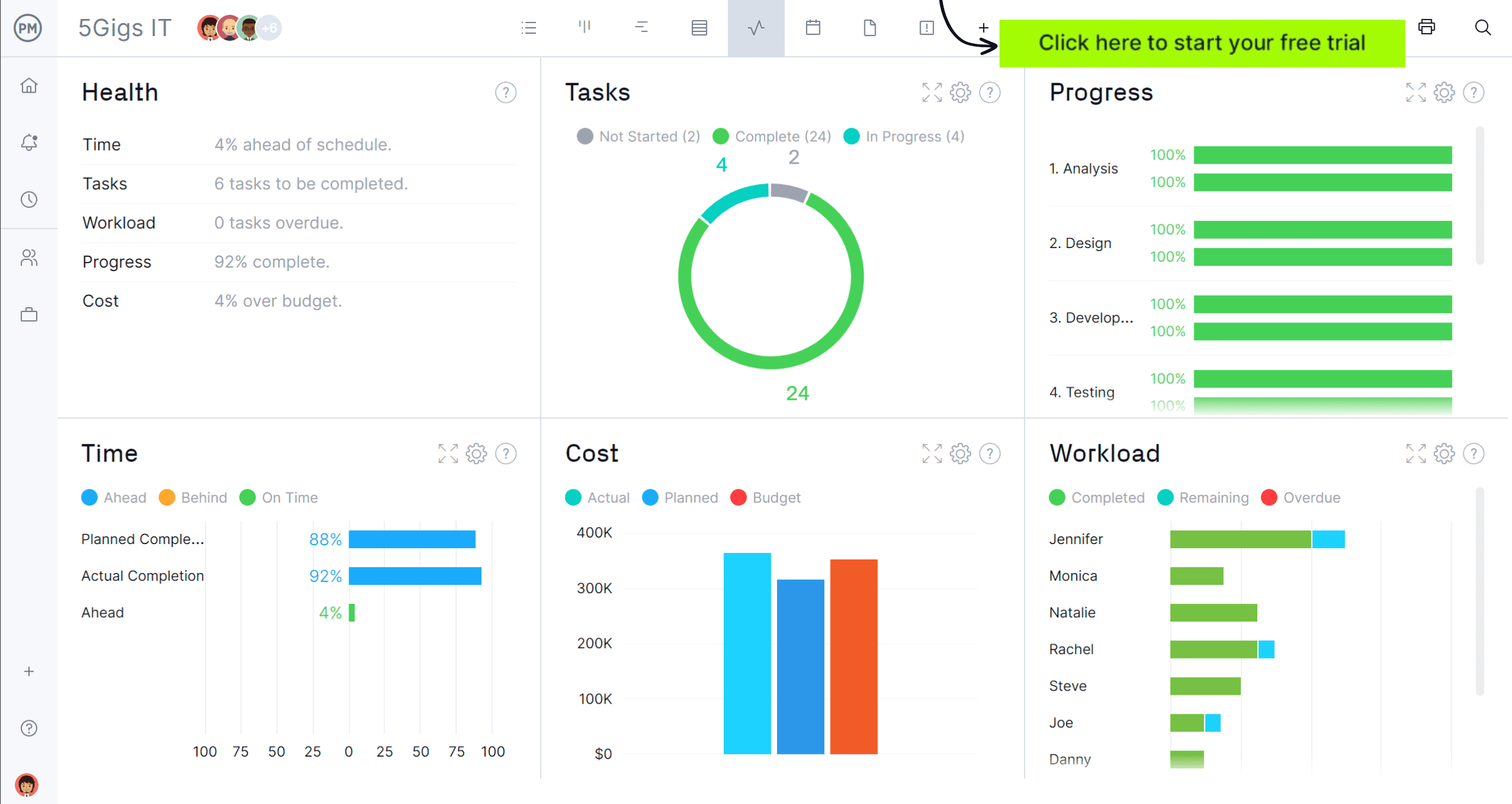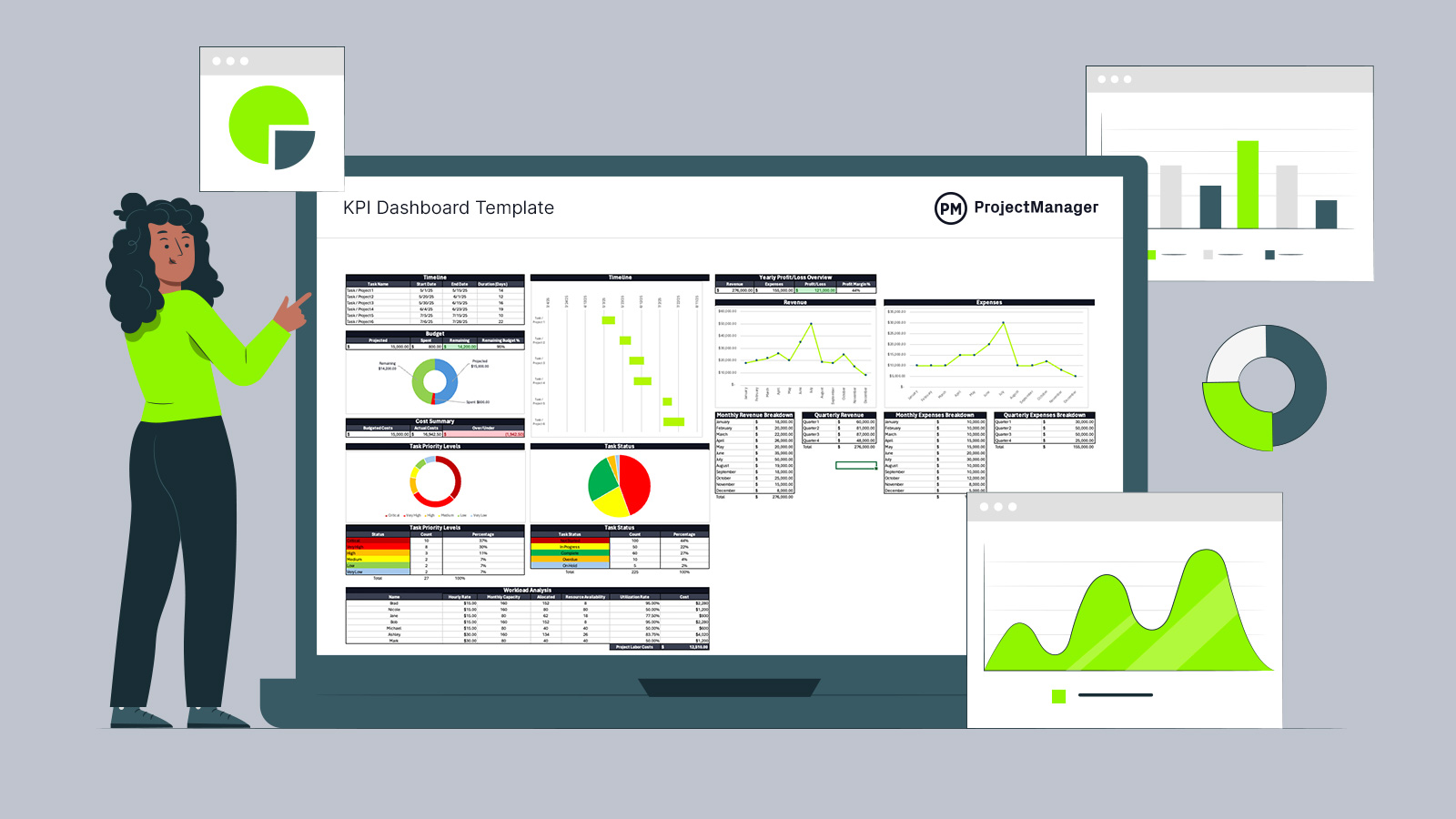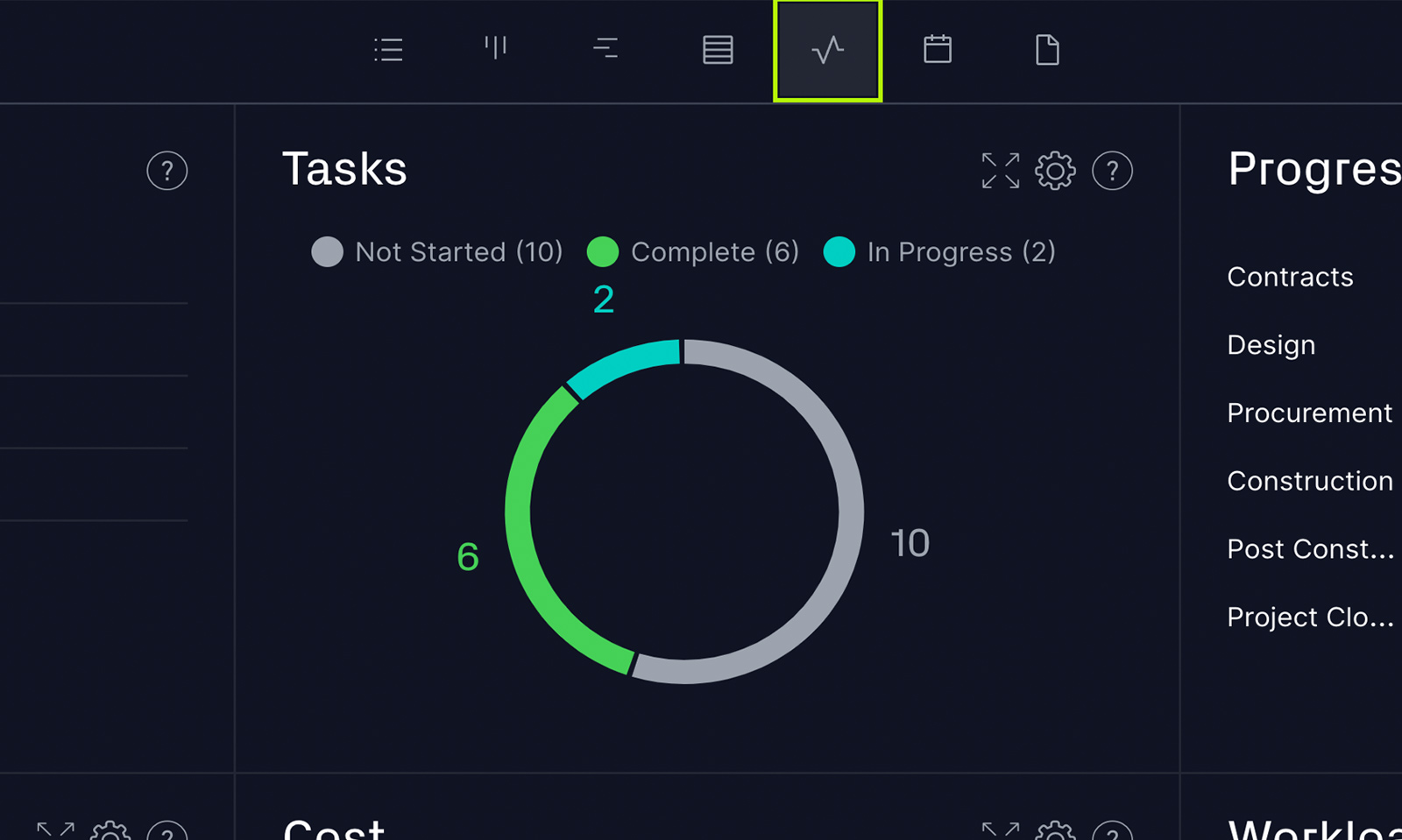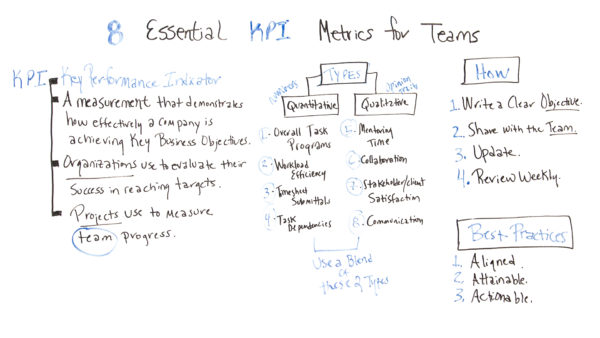If you’re looking for ways to increase productivity in your project (and who isn’t?), then you’ll need to know how to effectively measure your progress. Tracking these key performance indicators (KPI) will help keep the team productive and the project on track.
Having your eye on KPI metrics is one of the best ways to track the progress of your team. But first, let’s define some key terms and then get to the essential KPI metrics for teams.

What Is a KPI?
KPI is an acronym that stands for key performance indicator. It is a measurement that demonstrates how effectively a company is achieving its key business objectives. KPI metrics are often monitored with online dashboards or tracking templates. Organizations use KPI metrics to evaluate their success in reaching targets. When you use KPIs on projects, you’re measuring team and project progress.
The importance of KPIs is that they keep your project objective always on the front burner, so there’s little chance that you’ll leave them unattended. The project objectives must be communicated clearly throughout the project team, so everyone knows the KPIs they’re responsible for.
What Makes a KPI Effective?
For a KPI to be an effective project measurement, it first must be agreed on by everyone in the project and be meaningful to its intended audience, whether stakeholder or end-user.
The KPI metric must be quantifiable and able to be analyzed. It has to be measured regularly to have any team management value.
Naturally, all this is to say that the KPI is aligned with the overall objectives of the project and the organization. They must be realistic and cost-effective, and align with the culture of the organization, resource constraints or overall project constraints.

Get your free
KPI Dashboard Template
Use this free KPI Dashboard Template for Excel to manage your projects better.
Two Types of Team KPIs: Quantitative & Qualitative
There are two different types of KPIs: quantitative and qualitative. A quantitative KPI is measurable by numbers and a qualitative KPI is more descriptive, such as measuring through a survey to get an understanding of your end-user.
14 essential KPI metrics are listed below.
Quantitative Team KPIs
- Overall task programs: Provides measurable insights into project performance, efficiency and resource utilization. It includes data on task completion, milestone achievement, task duration, schedule variance, etc.
- Workload efficiency: Refers to how effectively team members use their time and resources to complete project tasks. This KPI can be calculated differently depending on the context and goals.
- Timesheet submittals: Tracks employee work hours to ensure accurate payroll and helps manage project costs. An example of a time worked calculation is end time – start time = hours worked.
- Task dependencies: Assigns measurable values to relationships between tasks to result in better analysis and prediction of project schedules. They are quantifiable through lead or lag time, critical path analysis, resource dependencies and more.
- Project schedule: Involves translating the planned project activities into measurable values to help objectively analyze and track progress. Quantify this project KPI through task durations, dependencies, milestones, critical path analysis and more.
- Cost variance (CV): Measures the difference between the budgeted and actual costs of the project. The formula is CV = earned value – actual cost.
- Milestone achievement: Notes the number of milestones completed on time. The formula is (number of milestones achieved / total number of planned milestones) * 100.
Qualitative Team KPIs
- Mentoring time: Refers to the time allocated for experienced project team members or managers to guide, support and develop less experienced members. This KPI focuses on skill development and career growth.
- Collaboration: Outlines the process of communication on project deliverables, whether it be in-person collaboration, commenting on tasks in a software, sending emails, etc.
- Stakeholder/client satisfaction: Gathers subjective feedback from stakeholders on their perception of project progress, communication and overall satisfaction. This KPI can be achieved through group discussions, informal feedback, interviews, etc.
- Communication: Ensures the project team and all relevant stakeholders are aligned on the project’s goals, objectives and progress. It’s helpful for building trust and understanding throughout the project.
- Team evaluation: Outlines how well the team is communicating and working together toward the project’s goals. KPI evaluations can take place both informally and formally to better understand how the team is working together.
- Project risk assessment: Identifies, analyzes and evaluates potential risks that could impact the project’s objectives. It’s a proactive approach to project KPIs that can mitigate potential problems before they arise.
- Deliverable assessment: Gathers qualitative feedback from stakeholders on the quality and usability of project deliverables. This feedback can help guide deliverables on future projects.
How to Use KPIs
In order to use key performance indicators effectively, you should blend the two types to get a complete metric for team performance. To achieve this, take these steps:
- Write a Clear Objective: What are you trying to measure and control? Be specific, the more pointed your objective, the better you’ll be able to measure and control.
- Share with the Team: Make sure those objectives are communicated throughout your project team, so everyone is on the same page. This, as noted, is crucial so that the KPIs are met throughout the project.
- Update: Regularly update the team, as objectives can change. A KPI is a moving target and to take a picture only once is not going to give you the data you need to get anything of value.
- Review Weekly: Meet weekly to make sure that as the project progresses, everyone stays informed on what you’re measuring and how. This is how you can track and control your project’s progress and communicate the most important topics to your team.
Best Practices for Team KPI Tracking
There are a lot of things that make a KPI effective, as noted above, but these three tips will keep your KPIs working accurately and effectively:
- Make sure the KPIs you created are aligned with the organization and project.
- Make sure they’re achievable and not unrealistic for your team.
- Make sure that they’re actionable.
If you use an online project management software, you’ll get live data, which means your team is able to update in real time. Not only does this lead to more accuracy, but with a real-time dashboard, you can see the project’s progress at a glance with easy-to-read graphs and charts.
KPI Dashboards
While there’s no one-size-fits-all approach to tracking project management KPIs, one of the easiest and most effective ways to do so is through a KPI dashboard. This powerful tool provides a comprehensive overview of project and health progress using updated data. As a result, project managers and stakeholders can see the project’s current status at a glance. Other roles that might use this KPI dashboard include functional managers, department heads, top management teams or C-level executives.
KPI Dashboard Template
For those interested in using a KPI dashboard but aren’t sure where to start, our free KPI dashboard template for Excel is the ideal place to start. It helps identify trends so businesses can stay alert of challenges or opportunities.
In our KPI dashboard template, users will find a section on the timeline, budget, task priority, task status, workload analysis, resource planning and profits and losses. There is even a revenue and expenses breakdown by month. Feel free to customize the template so it reflects the information you need to track.

How to Measure KPIs with ProjectManager
KPIs are only as good as the instrument you’re using to measure them. ProjectManager is a cloud-based project management software that instantly updates as teams update their statuses. These updates are displayed on our real-time dashboard, with widgets that track your tasks, costs, teams, project health and more.
Some of the KPIs you can monitor include your team’s workload. On the dashboard, you can see each individual team member’s progress. Our color-coded charts and graphs let you know if they’re on, ahead or behind schedule for time, cost, workload and tasks, with their percentage of progress calculated automatically.

When teams update their tasks and timesheets that information populates the dashboard to keep you on track when managing a project. No more having to calculate your KPIs on an overly complicated spreadsheet or by hand.

Your KPIs are only as good as the tools you use to track them, and no project management software offers you features like ProjectManager. But don’t take our word for it, try it yourself with this free 30-day trial.
Learn More About KPIs
KPIs can differ from organization to organization, but the essentials remain constant. Project managers understand how KPIs are a helpful benchmark to increase productivity in teams and improve costs, cycle time and stakeholder satisfaction.
But they’re more than just a performance tool, they can be used to motivate teams as well. Getting your team behind a common goal fosters positive competition. Meeting KPIs can be used as incentives and be rewarded to get even more out of your team. Watch Jennifer Bridges, PMP, to start your KPI adventure.
Here’s a screenshot for your reference.

Thanks for watching!
Transcription:
Today, we’re talking about Eight Essential KPI Metrics for Teams. But first of all, I want to talk about what a KPI is. I want to talk about two different types. I also want to talk about how we create them and a few best practices.
So first of all, what is a KPI? So, KPI is a key performance indicator, and it’s a measurement that demonstrates how effectively a company is at achieving key business objectives.
Organizations also use these to evaluate their success in reaching targets, but we can also use these in projects, and when used in projects, we’re looking to evaluate and measure the team’s progress.
So, let’s look at two different types. We have quantitative KPIs and qualitative KPIs. And when we’re talking about quantitative, we’re measuring those KPIs using numbers. When we talk about qualitative, we’re measuring the KPIs by opinions or traits.
So, the four quantitative ones that we commonly look at are the overall tasks programs. We’re also looking at the workload efficiency of the team, as well as timesheet submittals. How good or how regular and how accurate are they at submitting their timesheet? And also, looking at some of the task dependencies.
And when we look at qualitative, we’re considering how much time is spent with mentoring. We’re looking at collaboration and how much time is spent with collaboration. We’re looking at stakeholder and client satisfaction, as well as communication.
So, we want to use a blend of these two types. So how do we create these KPIs? How do we come up with them?
Well, first of all, we write a clear objective of what we’re trying to measure and control. And then, once we do that, we share that or those with the team. And then we update those on a regular basis and we review them weekly.
So, a few best practices are that you want to make sure that the KPIs that you create for your project or your team is aligned with your project and your organization.
You also want to make sure they’re attainable by your team members so they don’t become demotivators.
And you want to make sure they’re actionable.
Now, with project management software, these can be managed and updated in real time. And when your team members can update them in real time, there is a tendency towards more accuracy.
So, you can also use these in your dashboards and have a visual view so that not only you as the manager or project manager but also your team members can have insights into what’s going on on the project and the team’s progress.
So, if you need a tool to manage and track your KPIs and keep them visible for your team, then sign up for our software now at ProjectManager.

